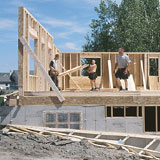The Labor Code Challenge
 One of the interesting things I have observed in construction/remodeling companies is the assumption that everybody’s interpretation of certain “givens” is the same. For example, a while ago I worked with a company whose job cost reports were consistently skewed within a pair of phases. It appeared that the estimator always underestimated on one category and overestimated in another. After some investigation it became obvious that the estimator was counting exterior prep and cleanup work under one phase heading and interior prep and cleanup work under a different phase heading. Meanwhile, everybody from laborers to lead carpenters was happily and consistently recording their time differently. Once there was clarification about what the estimator meant by a given labor code, the problem went away.
One of the interesting things I have observed in construction/remodeling companies is the assumption that everybody’s interpretation of certain “givens” is the same. For example, a while ago I worked with a company whose job cost reports were consistently skewed within a pair of phases. It appeared that the estimator always underestimated on one category and overestimated in another. After some investigation it became obvious that the estimator was counting exterior prep and cleanup work under one phase heading and interior prep and cleanup work under a different phase heading. Meanwhile, everybody from laborers to lead carpenters was happily and consistently recording their time differently. Once there was clarification about what the estimator meant by a given labor code, the problem went away.
The point is that it’s important to be sure that what goes into labor categories is well understood to avoid confusion, guesswork, and skewed reports. While it may seem obvious to the estimator that gutters belong with roofing, on site labor may find it equally legitimate to log gutter installation with exterior trim (after all, it’s attached to the fascia).
However, there is often an inverse relationship between accuracy of field data recording and number of labor codes available. In other words, given lots and lots of well-defined codes from which to draw, although it would seem logical to expect there to be fewer instances of inaccurate time logging (i.e. attributing time spent on a given task to the wrong labor code), my observations suggest that the long list of possible codes actually induces less accuracy. Field personnel have confided to me that they may pick a job code because “I haven’t used that in a while” or because they feel they “should have” spent time performing the task. When there are lots of categories with specific descriptions, any task that doesn’t quite fit may get relegated to an “other” category, if present. One office data enterer reported to me that the most frequently used of the 100+ labor codes was “Other.” Obviously, this situation leads to meaningless job cost reports for labor. So in a way, too-closely defining labor categories can work against you: with everything spelled out, too many tasks are excluded. An effective approach is to select a reasonable number of labor codes with clear titles, but leave it vague enough for your field personnel to make judgment calls. For example, it might work better to have Exterior Painting Prep and Exterior Painting as categories rather than Fill, First Sanding, Prime, First coat, Second Sanding, Second Coat, etc. If some grubby exterior requires a power wash, a specific but more all-inclusive category such as Exterior Painting Prep could be used. With the other, more specific categories, power washing might get stuck in Other.
The challenge is to create a balance between the estimator’s need to get useful data from “estimated vs. actual” job cost reports, the field worker’s need to record everything he does in the appropriate category, and the owner’s need to get good, phase-based financial data from the reports.
